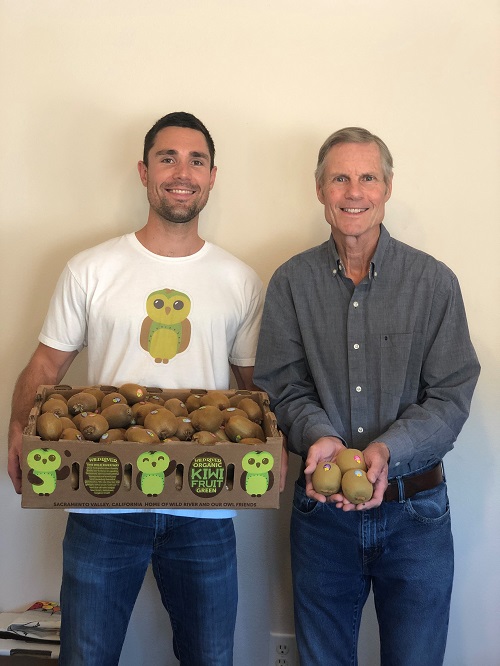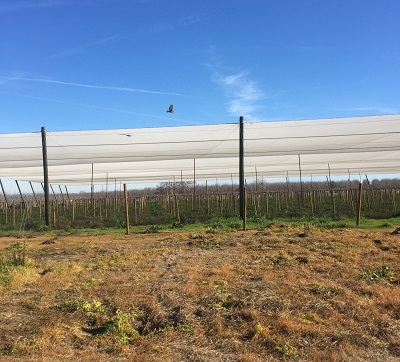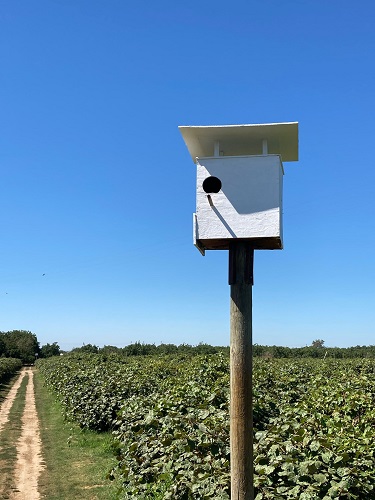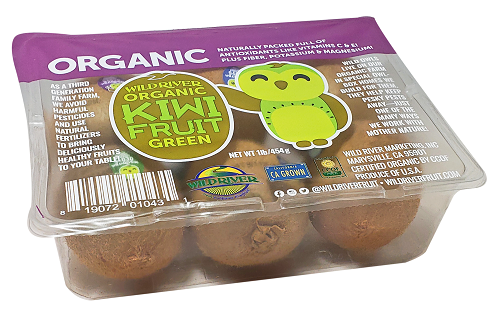At Wild River’s organic fruit farm, owls play a critical role addressing one of the greatest threats facing kiwifruit vineyards – pocket gophers and voles that wreak havoc on root systems.
Traditionally, many agriculture operations combat rodent threats by blasting holes in the ground with propane and oxygen, or by deploying poisonous baits, which have been known to cycle through the food chain. Such alternatives can be both unsanitary from a food safety perspective and harmful for conservation efforts aimed at supporting wild barn owls and other endangered bird species.

Travis and Mike Noland, Wild River Fruit
According to Mike Noland, second-generation leader of Wild River, these methods are also inferior in terms of efficacy as compared with constructing and maintaining owl boxes. “Although we rarely see our nocturnal helpers outside of their owl-box homes in the light of day, their contributions are irrefutable. Our resident owls have completely taken care of these pesky pests,” he said.
Recent studies conducted in the Yuba River region of the Sierra Nevada Mountains (where Wild River is located) indicate that the average family of barn owls consumes between 2,000 and 3,000 rodents each year while remaining faithful to nesting boxes for extended periods. Based on that number, Wild River estimates that barn owls living in more than 20 boxes across 400 acres are eliminating at least 40,000 rodents each year.

Owl at Wild River Fruit
Barn owls not only serve as the stars of Wild River’s Integrated Pest Management program, they also represent the face of the organic produce brand. “As we started thinking about the future of the Wild River label, we identified our owl friends as an ideal mascot – an endearing character capable of educating and engaging our customers about what it means to farm the Wild River Way,” said Travis Noland, who represents the third generation of Wild River Fruit.

Last season, Wild River debuted their green and gold kiwi owls across all kiwifruit packaging, from corrugated cartons to consumer packs and PLU stickers. This year, they are introducing Mandy the Mandarin Owl, Percy the Persimmon, and Pilot the Pluot, extending the brand across Wild River’s portfolio of organic fruit offerings. Conceived in partnership with graphic artist, Guy Rogers, of Sacramento-based Spark Creative Design, together with Ben Landis of Creative Externalities, each character was designed with its own unique color scheme and identifiable features corresponding to the fruit it represents.
“As we started thinking about the future of the Wild River label, we identified our owl friends as an ideal mascot – an endearing character capable of educating and engaging our customers about what it means to farm the Wild River Way.” -Travis Noland
While the owls embody Wild River’s approach to agriculture, they don’t tell the full story. As featured in an OPN article in 2018, Wild River was originally named for the rhythms of the Yuba River, which floods regularly, replenishing the land with fresh layers of topsoil.
As a CCOF certified organic farm, Wild River is surrounded by riparian corridors; more than 60 acres of rich forests that Wild River has preserved for nearly 60 years to sustain the natural ecosystem and provide habitat for rich wildlife. In addition to Wild River’s owl friends, the farm serves as a favorite haven for Red-tailed Hawks, Great Blue Herons, and countless other bird species.

An owl box at Wild River Fruit
Wild River also interplants many different crops in proximity with one another. Small blocks of various citrus, stonefruit, walnut, and other species flourish amongst green and gold kiwifruit vineyards, enticing diverse pollinators and beneficial insects.
Some kiwifruit vineyards have also been intercropped with other plant species such as persimmon trees that are trained along the kiwifruit pergola. Together with cover cropping across orchard floors, Wild River’s intercropping methods are employed with the intention of consistently promoting microbial activity through diverse plant residue and organic matter in the soil. Biodiverse agricultural systems are proven to enhance critical ecosystem functions, regulating and supporting services such as competition, pollination, predation, nitrogen fixation, and production, resulting in improved yields, soil fertility, pest suppression and other positive outcomes that contribute to farm sustainability.

“There is a history of viewing agriculture and nature at odds with one another,” said Noland. “In contrast, Wild River aims to turn that idea on its head by integrating both in order to improve production, offset inputs, and preserve natural ecosystems. It’s why we’ve oriented our brand platform and fruit offerings toward children whom we’ve identified as our number one target market. It’s our hope that future generations will regard nature as synergistic, if not synonymous with agriculture.”






